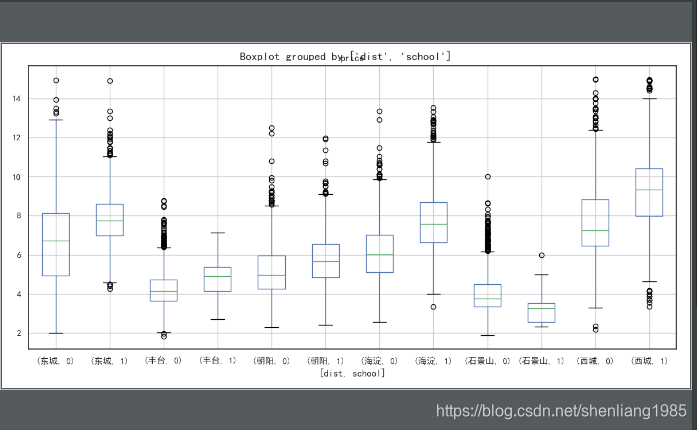Python描述性统计示例
1 声明
本文的数据来自网络,部分代码也有所参照,这里做了注释和延伸,旨在技术交流,如有冒犯之处请联系博主及时处理。
2 描述性统计分析简介
描述性统计分析是指运用制表和分类,图形以及计算概括性数据来描述数据特征的一种分析活动。因为本文采用的是Python语言,所以这里采用dataframe、pyplot里的方法来实现数据的描述性统计分析。
3 描述下二手房数据
import pandas as pd
import warnings # current version of seaborn generates a bunch of warnings that we'll ignore
warnings.filterwarnings("ignore")
import seaborn as sns
import matplotlib.pyplot as plt
sns.set(, color_codes=True)
def sndhsVisual():
##该数据集有区域、房间数、大厅数、面积数、楼层、有无地铁、有无学区、价格等字段
hsdata = pd.read_csv('input/sndHsPr.csv')
#print(hsdata.head())
##print(hsdata.price.quantile([0.25,0.5,0.75,0.4,0.5,0.6,0.7,0.8,0.9,1.0]))
##打印各个段的中位数
##print(hsdata.price.quantile([0.25,0.5,0.75,1.0]))
#定义区映射字段,方便图标展示
dictDist = {
u'chaoyang':"朝阳",
u'dongcheng':"东城",
u'fengtai':"丰台",
u'haidian':"海淀",
u'shijingshan':"石景山",
u'xicheng':"西城"
}
#对dist(地区)字段应用APPLY方法替换
hsdata.dist = hsdata.dist.apply(lambda x: dictDist[x])
from scipy import stats
import numpy as np
###print(type(stats.mode(hsdata.price)[0][0]))
##获取均值、中位数、标准差
print(hsdata.price.agg(['mean','median','std']))
#方法一通过stats.mode获取众数
mode = np.array(stats.mode(hsdata.price)[0][0].tolist())
mean_median=hsdata.price.agg(['mean', 'median', 'std']).as_matrix()
merger = np.hstack((mode, mean_median))
###print(type(merger)) ##类型为ndarray
##获取众数、均值、中位数、标准差
print(pd.Series(merger,index=['mode','mean', 'median', 'std']))
print('###############')
##方法二通过value_counts下的index.get_level_values获取众数
mode_n = hsdata['price'].value_counts(ascending=False).index.get_level_values(0).values[0]
print(pd.Series([mode_n],index=['mode']).append(hsdata.price.agg(['mean','median','std'])))
print('###############')
##大于0的,右偏数据
print("偏度"+str(hsdata['price'].skew())) # 大于0的,右偏数据
##小于0的,分散的
print("峰度"+str(hsdata['price'].kurtosis())) #小于0的,分散的
##print(hsdata.head(n=10)) # 这里可以指定n
##print(()) # 打印数据的信息(列名、数据行、为空记录数、数据类型)
##pd.set_option('display.width', 10) # 150,设置打印宽度
##pd.set_option('display.max_colwidth', 2)
hsdata.price = hsdata.price / 10000 # 以万为单位
pd.set_option('display.float_format', lambda x: '%.2f' % x) #指定数据显示为保留小数点后2位
#print(hsdata.describe(include =[np.number])) ## 这里对所有数字类型的查看数据描述,这里分不出连续变量、离散变量
## 通过describe方法查看变量的统计信息,变量分析-连续性型
print(hsdata[['area', 'price']].describe(include=[np.number])) ## 这里看连续型的更有意义
## 1 变量分析-离散型
#print(hsdata.columns.values)
for i in range(hsdata.columns.size):
if hsdata.columns.values[i] not in ('area','price'):
print("变量"+hsdata.columns.values[i]+"频次统计:")
'''
df1 = pd.DataFrame(hsdata[hsdata.columns.values[i]].value_counts()).T
df1.index=['value_cnt']
print(df1)
'''
df = hsdata[hsdata.columns.values[i]].agg(['value_counts']) #注意这里的[],是Series到DataFrame的过程
print(df.T)
print('\n')
else:
continue
## 2 变量分析-连续型
plt.rcParams['font.sans-serif']=['SimHei']
sns.distplot(hsdata.price,color='green',bins=20,kde=True,rug = False) #kde表示是否画出一条高斯核密度估计线,这里的密度对应频次,rug=True表示rug表示在x轴上每个观测上生成的小细条
plt.xlabel('房子单价 单位万/平米')
plt.ylabel('密度')
#plt.show()
'''
plt.hist(hsdata.price,bins=20)
plt.show()'''
##按照地区的中位数排名并记录为新的DataFrame
df_dist_price=pd.DataFrame(hsdata.groupby('dist').median().price.sort_values(ascending=True))
## 打印按照地区中位数升序的排名的索引值
print('按照地区中位数升序的排名:'+str(df_dist_price.index.values))
'''
# 方法1,借助dataframe的category类型对指定的list排序
data_tmp = hsdata[['dist', 'price']]
data_tmp.dist = data_tmp.dist.astype("category")
data_tmp.dist.cat.set_categories(["石景山", "丰台", "朝阳", "海淀", "东城", "西城"], inplace=True)
##dat1.dist.cat.set_categories(df_dist_price.index.values, inplace=True) 或者用这种方式替换
sns.boxplot(x='dist', y='price', data=data_tmp)
##data_tmp.boxplot(column='price',by='dist') 或者调用DataFrame的boxplot方法
plt.ylabel("房价单价(万元/平方米)")
plt.xlabel("城区")
plt.title("城区对房价的分组箱线图")
plt.show()
'''
## 方法2,借助sns.boxplot的order属性,这里的有两个分类变量加一个连续变量时X是其中一个,hue是另外个.
data_dist = hsdata[['dist', 'price']]
sns.boxplot(x='dist', y='price', data=data_dist, order=df_dist_price.index.values,hue=None)
plt.ylabel("单位面积房价(万元/平方米)")
plt.xlabel("城区")
plt.title("城区对房价的分组箱线图")
plt.show()
#房间数量与价格的描述性统计
data_rownum = hsdata[['roomnum','price']]
df_rownum_price_sort = pd.DataFrame(data_rownum.groupby('roomnum').median().price.sort_values(ascending=True))
sns.boxplot(x='roomnum',y='price',data=data_rownum,order=df_rownum_price_sort.index.values,hue=None)
plt.ylabel("单位面积房价(万元/平方米)");
plt.xlabel("房子室数")
plt.title("房子室数对房价的分组箱线图")
plt.show()
# 厅数与价格的描述性统计
##print(hsdata.groupby('halls').halls.agg(['count']))
#print(hsdata['halls'].value_counts())
#print("厅最大值:"+str(hsdata['halls'].max()))
data_halls = hsdata[['halls', 'price']]
data_halls = hsdata[['halls', 'price']]
df_halls_price_sort = pd.DataFrame(data_halls.groupby('halls').median().price.sort_values(ascending=True))
sns.boxplot(x='halls', y='price', data=data_halls, order=df_halls_price_sort.index.values, hue=None)
plt.ylabel("单位面积房价(万元/平方米)");
plt.xlabel("房子厅数")
plt.title("房子厅数对房价的分组箱线图")
plt.show()
'''
print(data_halls.groupby('halls').median().price.sort_index(ascending=False))
data_halls.halls = data_halls.halls.astype('category')
data_halls.halls.cat.set_categories([0, 1, 2, 3], inplace=True)
data_halls.boxplot(column='price', by='halls')
plt.show()
'''
'''hsdata[['area', 'price']].plot.scatter(x='price',y='area')
plt.show()'''
data_floor = hsdata[['floor', 'price']]
df_floor_price_sort = pd.DataFrame(data_floor.groupby('floor').median().price.sort_values(ascending=True))
sns.boxplot(x='floor', y='price', data=data_floor, order=df_floor_price_sort.index.values, hue=None)
plt.ylabel("单位面积房价(万元/平方米)");
plt.xlabel("楼层")
plt.title("楼层对房价的分组箱线图")
plt.show()
data_subway = hsdata[['subway', 'price']]
df_subway_price_sort = pd.DataFrame(data_subway.groupby('subway').median().price.sort_values(ascending=True))
sns.boxplot(x='subway', y='price', data=data_subway, order=df_subway_price_sort.index.values, hue=None)
plt.ylabel("单位面积房价(万元/平方米)");
plt.xlabel("地铁")
plt.title("地铁对房价的分组箱线图")
plt.show()
data_school = hsdata[['school', 'price']]
df_school_price_sort = pd.DataFrame(data_school.groupby('school').median().price.sort_values(ascending=True))
sns.boxplot(x='school', y='price', data=data_school, order=df_school_price_sort.index.values, hue=None)
plt.ylabel("单位面积房价(万元/平方米)");
plt.xlabel("学校")
plt.title("学校对房价的分组箱线图")
plt.show()
##地区与学区中位数统计
print(hsdata.groupby(['dist', 'school']).median().price.sort_index(ascending=False).unstack())
hsdata.boxplot(column='price', by=['dist', 'school'], figsize=(12, 6))
plt.show()
if __name__ == '__main__':
sndhsVisual()
4 执行结果
"D:\Program Files\Python37\python.exe" E:/dataVisual/Iris.py
mean 61151.810919
median 57473.000000
std 22293.358147
Name: price, dtype: float64
mode 50000.000000
mean 61151.810919
median 57473.000000
std 22293.358147
dtype: float64
###############
mode 50000.000000
mean 61151.810919
median 57473.000000
std 22293.358147
dtype: float64
###############
偏度0.6794935869486859
峰度-0.019305888544372873
area price
count 16210.00 16210.00
mean 91.75 6.12
std 44.00 2.23
min 30.06 1.83
25% 60.00 4.28
50% 78.83 5.75
75% 110.52 7.61
max 299.00 14.99
变量dist频次统计:
丰台 海淀 朝阳 东城 西城 石景山
value_counts 2947 2919 2864 2783 2750 1947
变量roomnum频次统计:
2 3 1 4 5
value_counts 7971 4250 3212 675 102
变量halls频次统计:
1 2 0 3
value_counts 11082 4231 812 85
变量floor频次统计:
middle high low
value_counts 5580 5552 5078
变量subway频次统计:
1 0
value_counts 13419 2791
变量school频次统计:
0 1
value_counts 11297 4913
按照地区中位数升序的排名:['石景山' '丰台' '朝阳' '海淀' '东城' '西城']
school 0 1
dist
东城 6.71 7.75
丰台 4.16 4.90
朝阳 4.96 5.67
海淀 6.02 7.56
石景山 3.77 3.28
西城 7.26 9.32
Process finished with exit code 0
结论:通过分析得到地区、有无地铁、是否学区房跟价格关联性较大。
例子中的图标:
城区房价箱线图
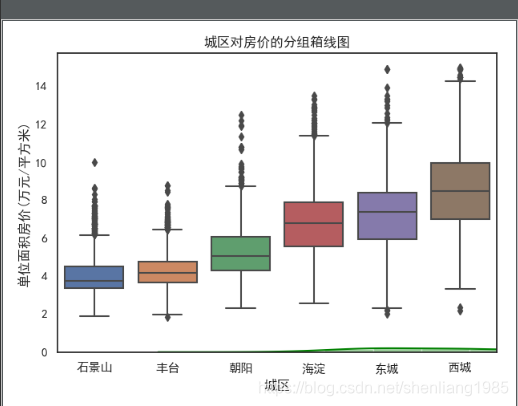
室数房价箱线图
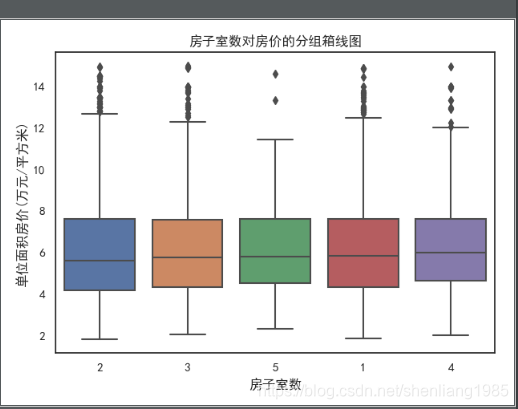
厅数房价箱线图:

楼层房价箱线图:
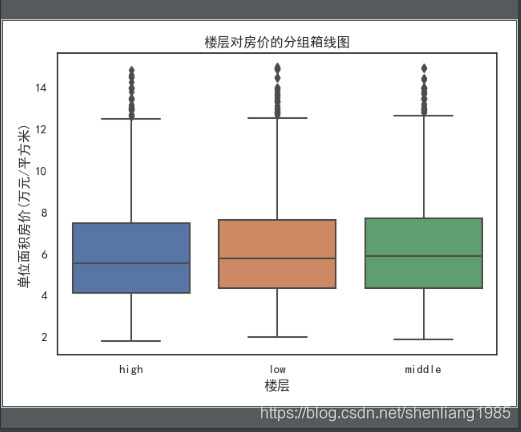
地铁房价箱线图:
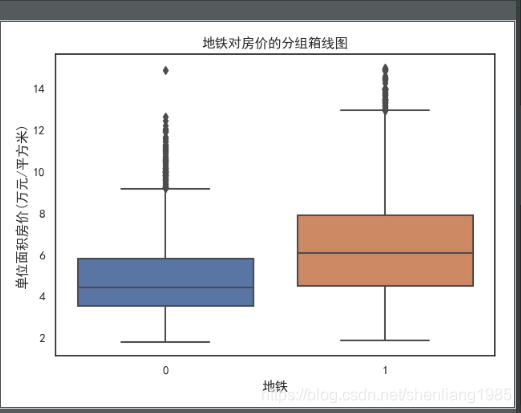
学校房价箱线图:
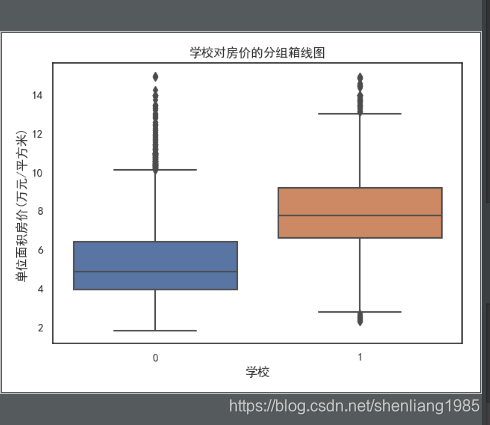
地区与学箱线图:
